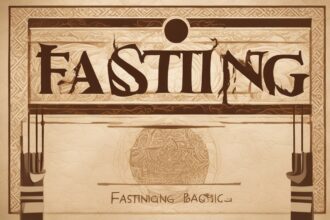Have you ever wondered why fasting, a practice as old as humanity itself, is making such a comeback in the health and wellness world? From intermittent fasting to extended water fasts, people are rediscovering the fasting benefits that our ancestors likely knew intuitively. Fasting isn’t just a trend; it’s a tradition deeply woven into the fabric of human history, spanning cultures, religions, and even medical practices. In this deep dive, we’ll explore the fascinating history of fasting, uncover its ancient roots, and connect it to modern science to show how this age-old practice can enhance your health today. Let’s journey through time and see why fasting remains a powerful tool for physical and mental well-being.
The Ancient Origins of Fasting
Fasting, at its core, is the voluntary abstinence from food or drink for a specific period. Its origins date back to prehistoric times when early humans didn’t have the luxury of three meals a day. Food scarcity meant periods of involuntary fasting were a norm, shaping our biology to adapt to feast-and-famine cycles. Some anthropologists suggest that this intermittent scarcity is why our bodies are wired to benefit from fasting, triggering mechanisms like fat-burning and cellular repair (Mattson & Wan, 2005). Beyond survival, fasting emerged as a deliberate act in ancient societies, often tied to spiritual purification or discipline. In ancient Egypt, for instance, fasting was practiced before important religious rituals to cleanse the body and soul. Similarly, indigenous cultures across the Americas used fasting as a rite of passage, believing it connected them to the divine. These early practices highlight that fasting wasn’t just about physical health—it was a holistic tool for mind and spirit, a theme that echoes in the fasting benefits we recognize today.
Fasting in Religious and Cultural Traditions
As civilizations evolved, fasting became a cornerstone of many religious and cultural traditions, often symbolizing self-control, penance, or devotion. In Christianity, fasting is observed during Lent, a 40-day period of reflection mirroring Jesus’ fast in the wilderness. Islam’s holy month of Ramadan involves fasting from dawn to dusk, fostering community and spiritual growth while offering health perks like improved insulin sensitivity (Trepanowski & Bloomer, 2010). Hinduism and Buddhism also embrace fasting, with practices like Ekadashi or meditative fasts aimed at mental clarity. Jewish traditions include fasting on Yom Kippur, the Day of Atonement, as a form of repentance. What’s striking is how these diverse practices, rooted in faith, align with modern research on fasting benefits—from weight management to mental focus. Fasting wasn’t just a test of willpower; it was a way to reset the body and mind, a concept we’re only now fully understanding through science.
Fasting in Ancient Medicine and Philosophy
Long before modern science, ancient healers and philosophers recognized the therapeutic potential of fasting. Hippocrates, often called the “Father of Medicine,” famously said, “Instead of using medicine, rather, fast a day.” He believed fasting allowed the body to heal itself by redirecting energy from digestion to recovery (Longo & Mattson, 2014). In ancient Greece, fasting was prescribed for ailments ranging from fevers to chronic conditions. Similarly, in traditional Chinese medicine, fasting was used to balance the body’s “qi” or life energy. Indian Ayurvedic practices also advocated periodic fasting to detoxify and rejuvenate. These early medical systems didn’t have labs or clinical trials, yet their observations about fasting’s restorative power are remarkably consistent with today’s findings on fasting health benefits, such as reduced inflammation and improved metabolic health. It’s almost as if our ancestors had an instinctive grasp of what science is now proving.
The Evolution of Fasting in the Modern Era
Fast forward to the 19th and 20th centuries, and fasting began to shift from a spiritual or survival practice to a structured health intervention. In the early 1900s, doctors like Herbert Shelton popularized “therapeutic fasting” in the United States, using it to treat conditions like obesity and digestive disorders. The rise of naturopathy also brought fasting into the spotlight as a natural detox method. By the mid-20th century, scientific interest grew, with studies exploring how fasting impacts metabolism and disease prevention. Today, intermittent fasting—cycling between eating and fasting windows—has become a household term, driven by research on fasting benefits like weight loss, better blood sugar control, and even longevity (de Cabo & Mattson, 2019). Social media and health influencers have further fueled its popularity, but the core idea remains the same: giving the body a break can yield profound results.
Scientific Insights into Fasting Benefits
So, why does fasting work? Modern science offers some compelling answers. When you fast, your body switches from using glucose as fuel to burning stored fat, a process called ketosis. This metabolic shift not only aids weight loss but also triggers autophagy, a cellular “clean-up” process where damaged cells are recycled, potentially slowing aging (Bagherniya et al., 2018). Fasting also lowers insulin levels, improving sensitivity and reducing the risk of type 2 diabetes (Barnard et al., 2019). Additionally, it can reduce markers of inflammation, a root cause of many chronic diseases. Studies even suggest fasting boosts brain health by increasing levels of brain-derived neurotrophic factor (BDNF), a protein linked to learning and memory (Mattson & Wan, 2005). These fasting benefits aren’t just theoretical—they’re measurable, making fasting a promising tool for preventive health. But it’s not a one-size-fits-all solution, so let’s explore how to approach it safely.
Practical Tips for Incorporating Fasting into Your Life
Interested in reaping the fasting benefits for yourself? Starting a fasting routine doesn’t have to be daunting, but it does require some planning, especially if you’re new to it. Here are some practical tips to ease into fasting while maximizing its health benefits of fasting and minimizing risks:
- Start Small: If you’re a beginner, try a 12:12 intermittent fasting schedule—12 hours of fasting (including sleep) and a 12-hour eating window. Gradually move to 16:8 as you get comfortable.
- Stay Hydrated: Drink plenty of water during fasting periods to avoid dehydration. Herbal teas or black coffee (without sugar) can also help curb hunger.
- Listen to Your Body: Fasting shouldn’t feel like punishment. If you feel dizzy or overly fatigued, break the fast with a light meal and reassess your approach.
- Focus on Nutrient-Dense Foods: When you eat, prioritize whole foods like vegetables, lean proteins, and healthy fats to support your body’s needs post-fast.
Additionally, here are some common pitfalls to avoid when starting your fasting journey:
- Overeating After Fasting: It’s tempting to binge after a fast, but this can negate benefits like calorie control. Plan balanced meals ahead of time.
- Ignoring Medical Conditions: If you have diabetes, are pregnant, or have a chronic illness, consult a healthcare provider before fasting.
- Pushing Too Hard, Too Soon: Extended fasts (over 24 hours) aren’t for everyone. Build up slowly to avoid stress on your body.
By starting with these tips and being mindful of your limits, you can safely explore the fasting advantages that have been celebrated for centuries. Remember, consistency and patience are key—fasting is a lifestyle, not a quick fix.
In conclusion, the history of fasting is a testament to its enduring value across time and cultures. From ancient spiritual rituals to modern scientific validation, fasting has proven to be more than a passing fad—it’s a practice grounded in both tradition and evidence. The fasting benefits, ranging from improved metabolic health to mental clarity, offer a compelling reason to consider incorporating it into your life. Whether you’re drawn to its historical significance or its potential to enhance well-being, fasting invites us to reconnect with a simpler, more intentional way of living. So, why not give it a try? Start small, stay informed, and discover how this ancient practice can support your modern health goals. Share your thoughts or experiences with fasting in the comments—I’d love to hear how it’s worked for you!
References
- Bagherniya, M., Butler, A. E., Barreto, G. E., & Sahebkar, A. (2018). The effect of fasting or calorie restriction on autophagy induction: A review of the literature. Ageing Research Reviews, 47, 183-197.
- Barnard, N. D., Levin, S. M., & Yokoyama, Y. (2019). A systematic review and meta-analysis of changes in body weight in clinical trials of vegetarian diets. Journal of the Academy of Nutrition and Dietetics, 119(2), 291-302.
- de Cabo, R., & Mattson, M. P. (2019). Effects of intermittent fasting on health, aging, and disease. New England Journal of Medicine, 381(26), 2541-2551.
- Longo, V. D., & Mattson, M. P. (2014). Fasting: Molecular mechanisms and clinical applications. Cell Metabolism, 19(2), 181-192.
- Mattson, M. P., & Wan, R. (2005). Beneficial effects of intermittent fasting and caloric restriction on the cardiovascular and cerebrovascular systems. The Journal of Nutritional Biochemistry, 16(3), 129-137.
- Trepanowski, J. F., & Bloomer, R. J. (2010). The impact of religious fasting on human health. Nutrition Journal, 9, 57.






